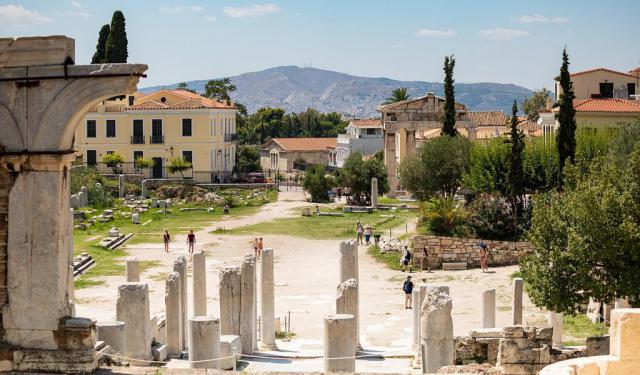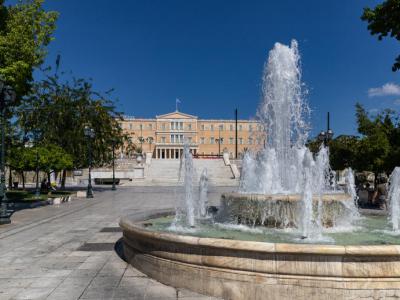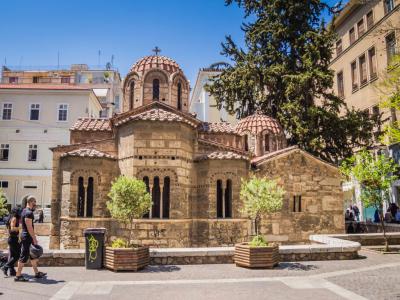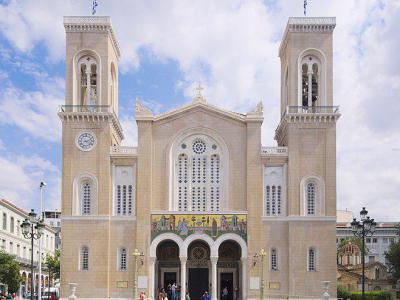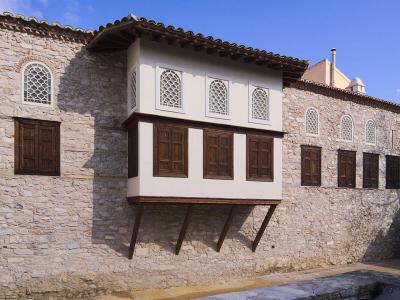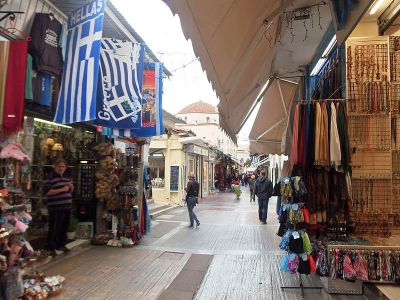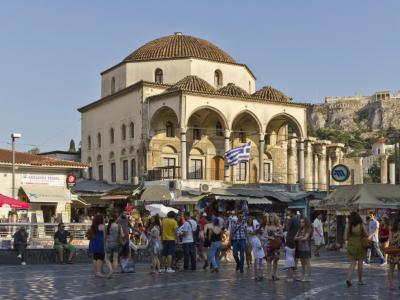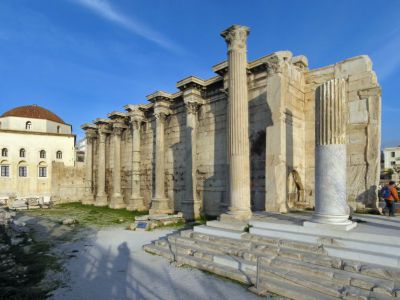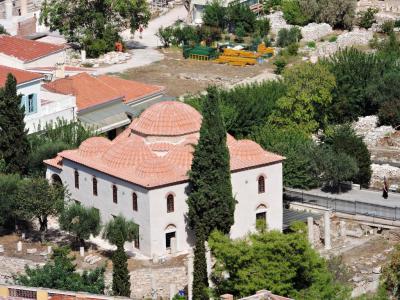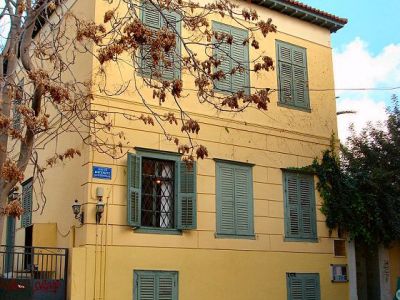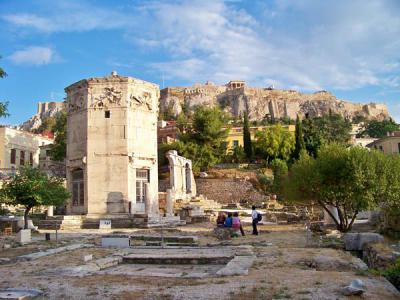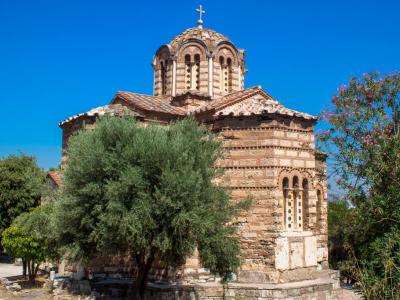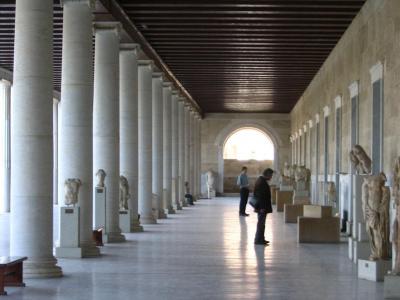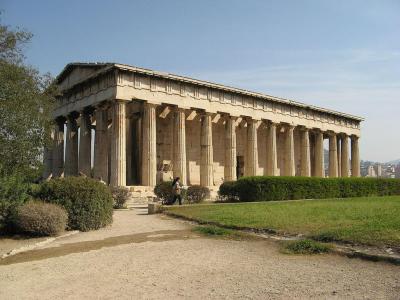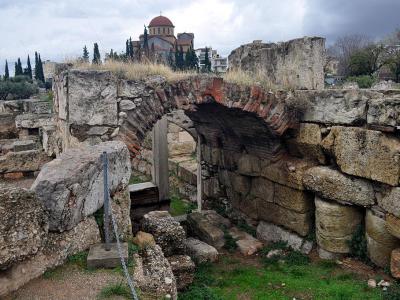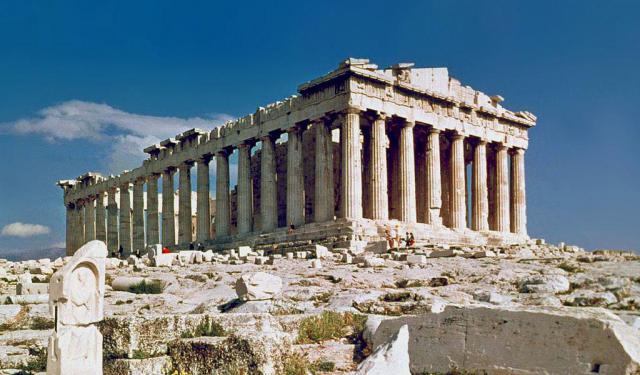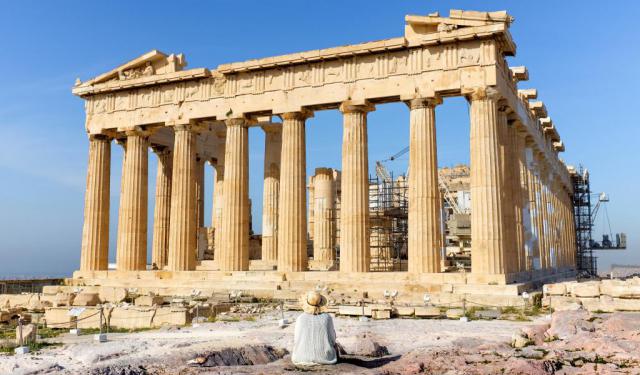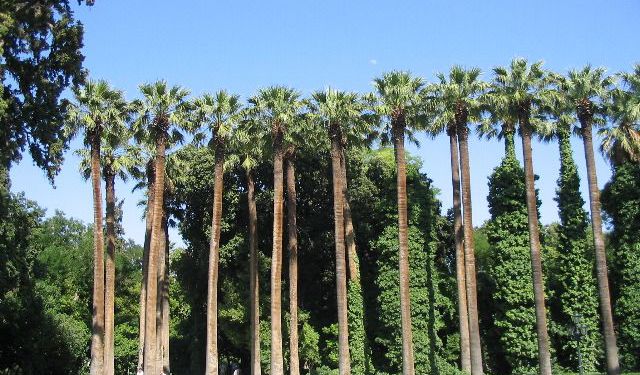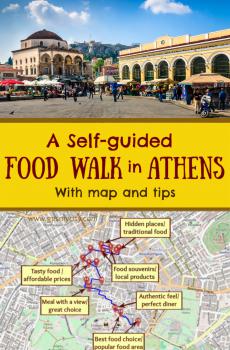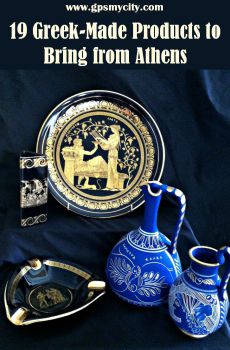Audio Guide: Plaka Attractions Walking Tour (Self Guided), Athens
Plaka, the oldest-and in many views, the most photogenic-district of Athens is where history isn’t just studied, it’s lived. Nestled at the foot of the mighty Acropolis, this is the "neighborhood of the Gods"-which sounds dramatic, but when you see it, you’ll understand why.
People have settled here since antiquity, so don’t be surprised if the walls seem to whisper ancient gossip. During the Ottoman period, from 1456 to 1833, Plaka was home to a mix of cultures, something still reflected in its architecture. Post-Greek independence, Athens started stretching its legs, but Plaka remained cozy and timeless. By the 20th century, its old-world charm had tourists swooning, leading to preservation efforts. Today, its winding narrow streets, historic buildings, Byzantine churches, and traditional tavernas serve up a living, breathing time capsule that does feel a little bit divine.
Start your adventure at Syntagma (or Constitution) Square, then meander down Ermou Street until-boom!-you stumble upon the Church of Kapnikarea, an adorable Byzantine gem perched atop the ruins of an ancient temple. Keep going deeper into Plaka’s heart, and you’ll find the Benizelos Mansion, a rare glimpse into Ottoman-era Athens, complete with the vibes of a bygone everyday life.
Time for a little browsing? Pandrossou Street is the place to be, pedestrian-friendly and packed with quirky shops. Then, turn your attention to the Tzistarakis Mosque and Fethiye Mosque, standing like long-lost architectural cousins-similar, yet not quite identical.
As you inch closer to the Acropolis, history thickens. You’ll pass the remains of Hadrian’s Library and the grand structures of the Roman Agora. But if you crave a quieter, more atmospheric stop, slip into an 1842 mansion housing a fascinating museum of Greek musical instruments. Because, let’s be honest, what’s Athens without a little melody?
On the final stretch, soak in the grandeur of the Ancient Agora Museum, gaze at the marvelously-preserved Temple of Hephaestus-Athens’ very own mini-Parthenon-and step into the Kerameikos Cemetery, where ancient Athens gets introspective. Walking the Street of Tombs, with its grand funerary monuments, is a different kind of history-one that whispers instead of shouts, but still leaves a lasting impression.
So, ready to time-travel through Athens' most picturesque district? Join us on this self-guided walking tour and lose yourself in the past-without actually getting lost.
People have settled here since antiquity, so don’t be surprised if the walls seem to whisper ancient gossip. During the Ottoman period, from 1456 to 1833, Plaka was home to a mix of cultures, something still reflected in its architecture. Post-Greek independence, Athens started stretching its legs, but Plaka remained cozy and timeless. By the 20th century, its old-world charm had tourists swooning, leading to preservation efforts. Today, its winding narrow streets, historic buildings, Byzantine churches, and traditional tavernas serve up a living, breathing time capsule that does feel a little bit divine.
Start your adventure at Syntagma (or Constitution) Square, then meander down Ermou Street until-boom!-you stumble upon the Church of Kapnikarea, an adorable Byzantine gem perched atop the ruins of an ancient temple. Keep going deeper into Plaka’s heart, and you’ll find the Benizelos Mansion, a rare glimpse into Ottoman-era Athens, complete with the vibes of a bygone everyday life.
Time for a little browsing? Pandrossou Street is the place to be, pedestrian-friendly and packed with quirky shops. Then, turn your attention to the Tzistarakis Mosque and Fethiye Mosque, standing like long-lost architectural cousins-similar, yet not quite identical.
As you inch closer to the Acropolis, history thickens. You’ll pass the remains of Hadrian’s Library and the grand structures of the Roman Agora. But if you crave a quieter, more atmospheric stop, slip into an 1842 mansion housing a fascinating museum of Greek musical instruments. Because, let’s be honest, what’s Athens without a little melody?
On the final stretch, soak in the grandeur of the Ancient Agora Museum, gaze at the marvelously-preserved Temple of Hephaestus-Athens’ very own mini-Parthenon-and step into the Kerameikos Cemetery, where ancient Athens gets introspective. Walking the Street of Tombs, with its grand funerary monuments, is a different kind of history-one that whispers instead of shouts, but still leaves a lasting impression.
So, ready to time-travel through Athens' most picturesque district? Join us on this self-guided walking tour and lose yourself in the past-without actually getting lost.
How it works: Download the app "GPSmyCity: Walks in 1K+ Cities" from Apple App Store or Google Play Store to your mobile phone or tablet. The app turns your mobile device into a personal tour guide and its built-in GPS navigation functions guide you from one tour stop to next. The app works offline, so no data plan is needed when traveling abroad.
Plaka Attractions Walking Tour Map
Guide Name: Plaka Attractions Walking Tour
Guide Location: Greece » Athens (See other walking tours in Athens)
Guide Type: Self-guided Walking Tour (Sightseeing)
# of Attractions: 14
Tour Duration: 2 Hour(s)
Travel Distance: 3.6 Km or 2.2 Miles
Author: emily
Sight(s) Featured in This Guide:
Guide Location: Greece » Athens (See other walking tours in Athens)
Guide Type: Self-guided Walking Tour (Sightseeing)
# of Attractions: 14
Tour Duration: 2 Hour(s)
Travel Distance: 3.6 Km or 2.2 Miles
Author: emily
Sight(s) Featured in This Guide:
- Syntagma Square (Constitution Square)
- Church of Panaghia Kapnikarea
- Metropolitan Cathedral
- Benizelos Mansion
- Pandrossou Street Market
- Tzistarakis Mosque
- Hadrian's Library
- Fethiye Mosque
- Museum of Greek Folk Musical Instruments
- Tower of the Winds
- Church of the Holy Apostles
- Stoa of Attalos and Ancient Agora Museum
- Temple of Hephaestus
- Kerameikos Ancient Cemetery
1) Syntagma Square (Constitution Square)
Constitution Square in Athens is where history, politics, and a good cup of coffee collide. This spacious landmark sits right in front of the 19th-century Royal Palace, which has been home to the Greek Parliament since 1935. And no, the square wasn’t just randomly named so-King Otto, Greece’s first monarch, was practically strong-armed into granting the country a Constitution here in 1843, thanks to a rather persuasive public and military uprising.
Nowadays, Constitution Square is still at the heart of the action. It’s not just a tourist hotspot-this is also Athens’ nerve center, linking visitors to top attractions by road, tram, bus, and subway. Political rallies, public gatherings, and plenty of people simply waiting for their Uber-this square sees it all on a regular basis.
Speaking of layout, Constitution Square has two levels-a bit like a giant marble stage set for both relaxation and spectacle. The central fountain, surrounded by benches, is perfect for a break, preferably with a Greek coffee in hand. Need WiFi? – No problem. Need a shade? – The pine and orange trees have you covered. And if caffeine calls, there are plenty of cafés ready to oblige. Oh, and in case you missed it, the whole square is clad in gleaming white marble, now with brand-new lampposts for that extra sparkle.
But the real showstopper is The Tomb of the Unknown Soldier. Guarded around the clock by the Evzones, Greece’s elite ceremonial soldiers, it’s a must-see. Their high-stepping routine, complete with kilts and pom-pom clogs, is as precise as it is fascinating. The tomb itself, unveiled on March 25, 1932, features a moving relief of a fallen Greek warrior (hoplite), forever frozen in time.
Tip:
If you fancy some retail therapy, just head to the lower end of the square-that’s where Ermou Street begins, Athens' ultimate shopping avenue. Happy strolling!
Nowadays, Constitution Square is still at the heart of the action. It’s not just a tourist hotspot-this is also Athens’ nerve center, linking visitors to top attractions by road, tram, bus, and subway. Political rallies, public gatherings, and plenty of people simply waiting for their Uber-this square sees it all on a regular basis.
Speaking of layout, Constitution Square has two levels-a bit like a giant marble stage set for both relaxation and spectacle. The central fountain, surrounded by benches, is perfect for a break, preferably with a Greek coffee in hand. Need WiFi? – No problem. Need a shade? – The pine and orange trees have you covered. And if caffeine calls, there are plenty of cafés ready to oblige. Oh, and in case you missed it, the whole square is clad in gleaming white marble, now with brand-new lampposts for that extra sparkle.
But the real showstopper is The Tomb of the Unknown Soldier. Guarded around the clock by the Evzones, Greece’s elite ceremonial soldiers, it’s a must-see. Their high-stepping routine, complete with kilts and pom-pom clogs, is as precise as it is fascinating. The tomb itself, unveiled on March 25, 1932, features a moving relief of a fallen Greek warrior (hoplite), forever frozen in time.
Tip:
If you fancy some retail therapy, just head to the lower end of the square-that’s where Ermou Street begins, Athens' ultimate shopping avenue. Happy strolling!
2) Church of Panaghia Kapnikarea
In the heart of modern Athens, the past and present do their daily dance. Right here, amid the high-energy, shop-till-you-drop chaos of Ermou Street, stands Kapnikarea-a charming Byzantine church that’s been stubbornly holding its ground since around 1050. That’s right, while today’s shoppers hunt for bargains, this little masterpiece has been casually watching history unfold for nearly a thousand years.
Like many early Christian structures, Kapnikarea wasn’t built from scratch. It took over prime real estate from an ancient Greek temple, likely dedicated to either Athena, the fierce protector of Athens, or Demeter, the goddess of the harvest. Talk about a divine property swap...
Much later, in the 19th century, Athens was getting a facelift. Enter King Otto I of Greece and his Bavarian architect, Leo von Klenze, who had grand plans to revamp the city. Kapnikarea-not exactly part of their modern vision-almost got the axe. But, plot twist! King Ludwig I of Bavaria, an art-loving, history-saving hero, intervened, ensuring the church survived. And let’s be honest, its slightly out-of-place vibe just makes it all the more intriguing.
Today, Kapnikarea is one of Athens’ most treasured churches. It’s a three-part complex: the main church, dedicated to the Virgin Mary, features a lovely colonnaded porch from the 12th century; a chapel to the north honors Saint Barbara; and a western exonarthex was added later for that extra touch of architectural flair.
Outside, you’ll spot a stunning mosaic from 1936, depicting the Virgin Mary holding baby Jesus. Step inside, and you’ll find Byzantine-inspired frescoes, some dating back to 1900.
One catch: Kapnikarea’s opening hours are as unpredictable as Athens’ traffic. So, if you find it open, consider it a lucky break and step inside. If not, well, at least you’ll have admired one of Athens’ most charming time capsules from the outside.
Like many early Christian structures, Kapnikarea wasn’t built from scratch. It took over prime real estate from an ancient Greek temple, likely dedicated to either Athena, the fierce protector of Athens, or Demeter, the goddess of the harvest. Talk about a divine property swap...
Much later, in the 19th century, Athens was getting a facelift. Enter King Otto I of Greece and his Bavarian architect, Leo von Klenze, who had grand plans to revamp the city. Kapnikarea-not exactly part of their modern vision-almost got the axe. But, plot twist! King Ludwig I of Bavaria, an art-loving, history-saving hero, intervened, ensuring the church survived. And let’s be honest, its slightly out-of-place vibe just makes it all the more intriguing.
Today, Kapnikarea is one of Athens’ most treasured churches. It’s a three-part complex: the main church, dedicated to the Virgin Mary, features a lovely colonnaded porch from the 12th century; a chapel to the north honors Saint Barbara; and a western exonarthex was added later for that extra touch of architectural flair.
Outside, you’ll spot a stunning mosaic from 1936, depicting the Virgin Mary holding baby Jesus. Step inside, and you’ll find Byzantine-inspired frescoes, some dating back to 1900.
One catch: Kapnikarea’s opening hours are as unpredictable as Athens’ traffic. So, if you find it open, consider it a lucky break and step inside. If not, well, at least you’ll have admired one of Athens’ most charming time capsules from the outside.
3) Metropolitan Cathedral
The Metropolitan Cathedral of Athens-or simply the "Metropolis", as the locals call it (because why bother with the full name when you can sound cool?). This grand cathedral has been standing tall since the mid-19th century, playing host to some of Greece’s most high-profile events-think royal weddings, state funerals, and the kind of ceremonies that make history books.
As for the story of its construction, it all started on Christmas Day, 1842, when someone had the bright idea to build a monumental church. But where to find all that marble? Easy-just dismantle 72 other churches across the country and re-purpose their stones. After 20 years and three architects juggling the job, the church was finally finished, proudly dedicated to the Annunciation of the Virgin. And its size-40 meters long, 20 meters wide, and 24 meters high-makes it the biggest religious building in Athens.
Step inside, and you’re greeted by a Greek Orthodox feast for the eyes: lavish icons, intricate murals, and an abundance of golden accents that make even the most skeptical visitor pause in awe. But beyond the grandeur, the cathedral also holds the tombs of two martyrs-Saint Philothéi, a woman who dedicated her life to rescuing Greek women from Ottoman harems (and was martyred for it in 1589), and Patriarch Gregory V, who was executed by the Ottomans in 1821. His body had quite the journey-rescued by Greek sailors from the Bosphorus, sent to Odessa (which is modern-day Ukraine), and eventually brought home to Athens 50 years later.
Out front, the statues tell even more stories. One honors the last Byzantine Emperor, who fought to the bitter end defending Constantinople in 1453. The other? A tribute to the Archbishop of Athens, a hero who helped protect the city’s Jewish community during World War II.
And if all this history has worked up your thirst, the square in front of the cathedral is the perfect place to sit back, sip a coffee, and take in the city’s rhythm-a little oasis amidst Athens' ever-busy streets.
As for the story of its construction, it all started on Christmas Day, 1842, when someone had the bright idea to build a monumental church. But where to find all that marble? Easy-just dismantle 72 other churches across the country and re-purpose their stones. After 20 years and three architects juggling the job, the church was finally finished, proudly dedicated to the Annunciation of the Virgin. And its size-40 meters long, 20 meters wide, and 24 meters high-makes it the biggest religious building in Athens.
Step inside, and you’re greeted by a Greek Orthodox feast for the eyes: lavish icons, intricate murals, and an abundance of golden accents that make even the most skeptical visitor pause in awe. But beyond the grandeur, the cathedral also holds the tombs of two martyrs-Saint Philothéi, a woman who dedicated her life to rescuing Greek women from Ottoman harems (and was martyred for it in 1589), and Patriarch Gregory V, who was executed by the Ottomans in 1821. His body had quite the journey-rescued by Greek sailors from the Bosphorus, sent to Odessa (which is modern-day Ukraine), and eventually brought home to Athens 50 years later.
Out front, the statues tell even more stories. One honors the last Byzantine Emperor, who fought to the bitter end defending Constantinople in 1453. The other? A tribute to the Archbishop of Athens, a hero who helped protect the city’s Jewish community during World War II.
And if all this history has worked up your thirst, the square in front of the cathedral is the perfect place to sit back, sip a coffee, and take in the city’s rhythm-a little oasis amidst Athens' ever-busy streets.
4) Benizelos Mansion
The Benizelos Mansion, Athens’ last-standing konaki – the aristocratic Ottoman-style urban home – is often missed by tourists. Tucked away in the city, this hidden gem somehow dodges the guidebook limelight, but lucky for you, it is open to explore free of charge (although, a little donation is always welcome).
Built in the early 18th century, this two-story, stone-meets-timber residence once belonged to one of Athens' wealthiest families. It wasn’t just a fancy home-it was part of a much larger estate, possibly with a medieval olive press (because what’s a Greek mansion without a little olive oil history?). Today, it stands as a rare glimpse into the architecture of the late Ottoman period.
Inside, an exhibition-available in English and Greek-brings the past to life through visuals, audio, and interactive displays. One of the home’s most famous former residents, Saint Philothei, was a noblewoman-turned-monastic who devoted her life to philanthropy. Her relics now rest in the Metropolitan Cathedral of Athens-because, naturally, she was too important for just a family portrait on the wall.
Downstairs, the ground floor was all business. Three rooms and a grand portico stored the household essentials: grain, oil, wine-aka survival basics. A well and a wash basin built into the staircase hint at an advanced water system (because even 18th-century aristocrats knew the importance of plumbing).
Upstairs, things got cozy. The main living space revolved around the living quarters and the open corridor, with separate winter and summer rooms. The winter space had a fireplace for those ‘chilly’ Athenian nights, while the summer room featured stained-glass screens for a breezy, sunlit vibe.
But the real highlight is the enclosed balcony on the south façade, overlooking the courtyard garden-a slice of serenity in the middle of modern Athens. With its fine craftsmanship, Ottoman design, and a history full of intrigue, the Benizelos Mansion is more than just an old house-it’s an 18th-century time capsule waiting to be explored. So, why not step inside and let history do the talking?
Built in the early 18th century, this two-story, stone-meets-timber residence once belonged to one of Athens' wealthiest families. It wasn’t just a fancy home-it was part of a much larger estate, possibly with a medieval olive press (because what’s a Greek mansion without a little olive oil history?). Today, it stands as a rare glimpse into the architecture of the late Ottoman period.
Inside, an exhibition-available in English and Greek-brings the past to life through visuals, audio, and interactive displays. One of the home’s most famous former residents, Saint Philothei, was a noblewoman-turned-monastic who devoted her life to philanthropy. Her relics now rest in the Metropolitan Cathedral of Athens-because, naturally, she was too important for just a family portrait on the wall.
Downstairs, the ground floor was all business. Three rooms and a grand portico stored the household essentials: grain, oil, wine-aka survival basics. A well and a wash basin built into the staircase hint at an advanced water system (because even 18th-century aristocrats knew the importance of plumbing).
Upstairs, things got cozy. The main living space revolved around the living quarters and the open corridor, with separate winter and summer rooms. The winter space had a fireplace for those ‘chilly’ Athenian nights, while the summer room featured stained-glass screens for a breezy, sunlit vibe.
But the real highlight is the enclosed balcony on the south façade, overlooking the courtyard garden-a slice of serenity in the middle of modern Athens. With its fine craftsmanship, Ottoman design, and a history full of intrigue, the Benizelos Mansion is more than just an old house-it’s an 18th-century time capsule waiting to be explored. So, why not step inside and let history do the talking?
5) Pandrossou Street Market
Pandrosou is one of the oldest, liveliest, and most unapologetically Greek streets in Athens. Back in the 19th century, this was a thriving marketplace-up until 1885, when a fire destroyed much of it. But like a true Athenian, Pandrosou bounced back, and today, it’s a bustling hub where old-world charm meets modern shopping temptations.
What’s on offer?-Everything. Clothing, souvenirs, handmade crafts, food, jewelry, and artwork-you name it, they sell it. Imagine the ancient Agora just a stone’s throw away, whispering tales of barter and trade, while today’s merchants display both traditional Greek treasures and trendy designs.
With nearly 100 shops, this street is a shopper’s paradise. Some of these businesses have been in the same family for generations-take Nick’s Corner, for example, where the hospitality is as warm as a Greek summer. Whether you’re after a postcard, a religious icon, a hand-painted bouzouki (musical instrument), or some locally made olive oil, you’ll find it here. And if it’s Sunday? Well, expect a full-on flea market experience, complete with bargain-priced clothes, jewelry, and street food that could convert you into a lifelong fan of Greek cuisine.
One small note of caution: If you’re planning to take home an ancient Greek, Roman, or Byzantine artifact, be aware that customs might have a few questions...
Tip:
At No. 36, the Centre for Hellenic Traditions showcases handcrafted items from across Greece. Meanwhile, at No. 50, Martinos Antiques is a four-story wonderland for collectors-whether you fancy an 18th-century dowry chest, a vintage sword, or a piece of Venetian glass, this place is packed with stories waiting to be rediscovered.
So, if you want a shopping experience with a side of history, Pandrosou Street is calling your name!
What’s on offer?-Everything. Clothing, souvenirs, handmade crafts, food, jewelry, and artwork-you name it, they sell it. Imagine the ancient Agora just a stone’s throw away, whispering tales of barter and trade, while today’s merchants display both traditional Greek treasures and trendy designs.
With nearly 100 shops, this street is a shopper’s paradise. Some of these businesses have been in the same family for generations-take Nick’s Corner, for example, where the hospitality is as warm as a Greek summer. Whether you’re after a postcard, a religious icon, a hand-painted bouzouki (musical instrument), or some locally made olive oil, you’ll find it here. And if it’s Sunday? Well, expect a full-on flea market experience, complete with bargain-priced clothes, jewelry, and street food that could convert you into a lifelong fan of Greek cuisine.
One small note of caution: If you’re planning to take home an ancient Greek, Roman, or Byzantine artifact, be aware that customs might have a few questions...
Tip:
At No. 36, the Centre for Hellenic Traditions showcases handcrafted items from across Greece. Meanwhile, at No. 50, Martinos Antiques is a four-story wonderland for collectors-whether you fancy an 18th-century dowry chest, a vintage sword, or a piece of Venetian glass, this place is packed with stories waiting to be rediscovered.
So, if you want a shopping experience with a side of history, Pandrosou Street is calling your name!
6) Tzistarakis Mosque
Athens spent centuries under Ottoman rule, but you wouldn’t know it just by looking around-most Ottoman-era structures have vanished, thanks to archaeologists who prefer digging up even older treasures. But one survivor, impossible to miss, still stands tall in Monastiraki Square: the Tzistarakis Mosque, the largest remaining Ottoman building in the Greek capital.
Built in 1759 under the watchful eye of Turkish governor Tzistarakis, the mosque sports one big central dome and two smaller ones, a design that sticks out in an area dominated by classical Greek aesthetics. While no longer a place of worship, today it houses an exhibition of ceramics, sculptures, and decorative arts, mostly from the Kyriazopoulos family's private collection. It may not be the Louvre, but what it lacks in size, it makes up for in charm-featuring rare and curious finds from different parts of Greece, including works linked to the Center for the Study of Traditional Pottery. If you need a break from Monastiraki’s never-ending flea market frenzy, this is your spot.
Now, here’s a scandalous little historical tidbit: the mosque was built using limestone from one of the pillars of the Temple of the Olympian Zeus-which was a big no-no. The Turkish Sultan himself had banned the destruction of ancient ruins, and locals, ever superstitious, feared that tearing down temples could bring plagues. When word got out, people were furious. The Sultan swiftly exiled Tzistarakis, but that wasn’t enough-he was later assassinated. Some workplace hazard, indeed...
After the Greek War of Independence, the mosque was repurposed as a meeting hall for elders before the Greek government claimed it. Over the years, it served as a prison, barracks, warehouse, and even a military concert venue. Sometime between 1839 and 1843, the minaret was demolished, ensuring that its days as a mosque were well and truly over.
So, whether you're here for the history, the architecture, or just a moment of peace, the Tzistarakis Mosque is worth a quick stop.
Built in 1759 under the watchful eye of Turkish governor Tzistarakis, the mosque sports one big central dome and two smaller ones, a design that sticks out in an area dominated by classical Greek aesthetics. While no longer a place of worship, today it houses an exhibition of ceramics, sculptures, and decorative arts, mostly from the Kyriazopoulos family's private collection. It may not be the Louvre, but what it lacks in size, it makes up for in charm-featuring rare and curious finds from different parts of Greece, including works linked to the Center for the Study of Traditional Pottery. If you need a break from Monastiraki’s never-ending flea market frenzy, this is your spot.
Now, here’s a scandalous little historical tidbit: the mosque was built using limestone from one of the pillars of the Temple of the Olympian Zeus-which was a big no-no. The Turkish Sultan himself had banned the destruction of ancient ruins, and locals, ever superstitious, feared that tearing down temples could bring plagues. When word got out, people were furious. The Sultan swiftly exiled Tzistarakis, but that wasn’t enough-he was later assassinated. Some workplace hazard, indeed...
After the Greek War of Independence, the mosque was repurposed as a meeting hall for elders before the Greek government claimed it. Over the years, it served as a prison, barracks, warehouse, and even a military concert venue. Sometime between 1839 and 1843, the minaret was demolished, ensuring that its days as a mosque were well and truly over.
So, whether you're here for the history, the architecture, or just a moment of peace, the Tzistarakis Mosque is worth a quick stop.
7) Hadrian's Library
While not much remains of this Roman-era library today, back in the 2nd century AD, it was the place to be. Imagine a massive cloistered courtyard, a hundred grand columns, and enough space to make even the most extravagant book hoarder jealous. And who do we have to thank for this intellectual paradise?-Emperor Hadrian, the ultimate fanboy of Greek culture. In fact, he was so enamored with it, that they nicknamed him “Graecula” (which means “Little Greek”).
He decked out this sprawling complex with art galleries, lecture halls, and a magnificent public space-because why stop at books when you can have everything? His reign ushered in a golden age of peace and prosperity, giving arts and culture a serious upgrade across the empire.
In its prime, the library housed precious papyrus scrolls and exquisite artworks-until the barbaric Herules (from modern-day Germany) came knocking (not for a book club meeting, unfortunately). After their invasion, a Roman official named Herculius took on restoration duties, but history had more plans for the ruins. Over time, they became the foundations for not one, not two, but three different churches-a Byzantine one in the 5th century, another in the 7th, and a cathedral in the 12th. That's what they call re-purposing real estate!
These days, the site is finally open to the public, though excavation is still ongoing. A few original Corinthian columns have survived the centuries, hinting at the library’s former grandeur. And here’s a fun twist: the remains of the Tetraconch Church, smack in the middle of the ruins, were built entirely inside the library’s old courtyard.
Tip:
Your Acropolis ticket covers entry, so if you’re in the area, it’s a no-brainer to check it out. Or, if you’re feeling more mysterious, just walk along the perimeter fence and steal a few glances through the gaps-because who doesn’t love a little architectural intrigue?
He decked out this sprawling complex with art galleries, lecture halls, and a magnificent public space-because why stop at books when you can have everything? His reign ushered in a golden age of peace and prosperity, giving arts and culture a serious upgrade across the empire.
In its prime, the library housed precious papyrus scrolls and exquisite artworks-until the barbaric Herules (from modern-day Germany) came knocking (not for a book club meeting, unfortunately). After their invasion, a Roman official named Herculius took on restoration duties, but history had more plans for the ruins. Over time, they became the foundations for not one, not two, but three different churches-a Byzantine one in the 5th century, another in the 7th, and a cathedral in the 12th. That's what they call re-purposing real estate!
These days, the site is finally open to the public, though excavation is still ongoing. A few original Corinthian columns have survived the centuries, hinting at the library’s former grandeur. And here’s a fun twist: the remains of the Tetraconch Church, smack in the middle of the ruins, were built entirely inside the library’s old courtyard.
Tip:
Your Acropolis ticket covers entry, so if you’re in the area, it’s a no-brainer to check it out. Or, if you’re feeling more mysterious, just walk along the perimeter fence and steal a few glances through the gaps-because who doesn’t love a little architectural intrigue?
8) Fethiye Mosque
Just a stone’s throw from the Roman Forum, you’ll stumble upon one of Athens’ rare reminders of the Ottoman era. Enter the Fethiye Mosque, the city's oldest, built in 1458 atop the ruins of an 8th-century Byzantine basilica. It was commissioned by none other than Sultan Mehmet II himself-yes, the same guy who conquered Constantinople in 1453. Clearly a multitasker, he also had an appreciation for ancient Greek philosophers. The mosque’s name, “Fethiye,” means “conquest” in Turkish, but the Athenians, not exactly thrilled about their occupiers, skipped the history lesson and called it the Wheatmarket Mosque-because, well, there was a wheat market next door. Practical folks, those Athenians...
Fast-forward to the Morean War (in 1687-1688), when the Venetians briefly took over Athens and decided the mosque would make a great Catholic church dedicated to Dionysius the Areopagite. That didn’t last long, and by the early 19th century, after Greek independence, the minaret was taken down. The building then embarked on a very non-religious second life-first as a school, then as a barracks, then a military prison, and for a grand finale… a military bakery. Indeed, why not-nothing says “re-purposing” like fresh bread.
Today, the mosque still stands with its grand porticoed entrance, though you can’t go inside-it's now an archaeological storage facility (which is historian-speak for “off-limits”). But if you cross Eólou Street, right across from the Roman Forum, you’ll spot what’s left of a medrese (an Ottoman-era Islamic school), complete with a gateway and a single dome that have somehow outlasted centuries of change. A quiet reminder that history, much like Athens itself, is full of unexpected twists.
Fast-forward to the Morean War (in 1687-1688), when the Venetians briefly took over Athens and decided the mosque would make a great Catholic church dedicated to Dionysius the Areopagite. That didn’t last long, and by the early 19th century, after Greek independence, the minaret was taken down. The building then embarked on a very non-religious second life-first as a school, then as a barracks, then a military prison, and for a grand finale… a military bakery. Indeed, why not-nothing says “re-purposing” like fresh bread.
Today, the mosque still stands with its grand porticoed entrance, though you can’t go inside-it's now an archaeological storage facility (which is historian-speak for “off-limits”). But if you cross Eólou Street, right across from the Roman Forum, you’ll spot what’s left of a medrese (an Ottoman-era Islamic school), complete with a gateway and a single dome that have somehow outlasted centuries of change. A quiet reminder that history, much like Athens itself, is full of unexpected twists.
9) Museum of Greek Folk Musical Instruments
Imagine dedicating a good half a century of your life to collecting, studying, and preserving folk music. That’s exactly what the esteemed Cretan musicologist Phoivos Anogianákis did. In 1978, instead of hoarding his treasure trove of over 1,200 musical instruments like a mythical dragon guarding gold, he generously handed it over to the Greek state. 14 years later, a museum bearing his name opened its doors, celebrating the vibrant history of Greek folk and popular music, with his spectacular collection taking center stage.
Now, this isn’t just any museum. Housed in a charming 1842 mansion-once the home of a well-to-do Athenian family-it tells the tale of Greek music, from island tunes to the smoky, sorrowful sounds of rempétika, the Greek answer to the blues, which arrived from Smyrna in 1922.
Inside, instruments from every corner of Greece are neatly arranged into four categories: drums, wind instruments, string instruments, and bells. Some are humble, others are absolute masterpieces. And because just looking at them isn’t enough, the museum provides photos, headphones to hear their unique sounds, and even historic videos showing these instruments in action-because nothing illustrates "folk tradition" better than a lively village festival.
Venture down to the basement, and you’ll find an eclectic mix of church bells, livestock bells, water whistles, wooden clappers, and flutes. Meanwhile, wind instruments like the tsampoúna (a goatskin bagpipe with serious character) and the Cretan lýra (small in size, but mighty in sound) proudly claim their spots on display.
Tip:
The courtyard is a lifesaver on sweltering summer days, and if luck is on your side, you might catch a live concert. There’s also a tiny bookstore packed with books and CDs for the true folk music enthusiast. And don’t be shy to ask-the friendly staff is happy to help. Otherwise, you’re free to roam, explore, and soak up the sounds of Greece at your own pace.
Now, this isn’t just any museum. Housed in a charming 1842 mansion-once the home of a well-to-do Athenian family-it tells the tale of Greek music, from island tunes to the smoky, sorrowful sounds of rempétika, the Greek answer to the blues, which arrived from Smyrna in 1922.
Inside, instruments from every corner of Greece are neatly arranged into four categories: drums, wind instruments, string instruments, and bells. Some are humble, others are absolute masterpieces. And because just looking at them isn’t enough, the museum provides photos, headphones to hear their unique sounds, and even historic videos showing these instruments in action-because nothing illustrates "folk tradition" better than a lively village festival.
Venture down to the basement, and you’ll find an eclectic mix of church bells, livestock bells, water whistles, wooden clappers, and flutes. Meanwhile, wind instruments like the tsampoúna (a goatskin bagpipe with serious character) and the Cretan lýra (small in size, but mighty in sound) proudly claim their spots on display.
Tip:
The courtyard is a lifesaver on sweltering summer days, and if luck is on your side, you might catch a live concert. There’s also a tiny bookstore packed with books and CDs for the true folk music enthusiast. And don’t be shy to ask-the friendly staff is happy to help. Otherwise, you’re free to roam, explore, and soak up the sounds of Greece at your own pace.
10) Tower of the Winds
At the Tower of the Winds, you have science, mythology, and a touch of irony collide in an exquisite octagonal package. Standing proudly at 12 meters tall, this marble masterpiece was ancient Athens' answer to the weather app, a multi-functional timepiece that not only told the time but also predicted the wind’s next move. Think of it as a 2,000-year-old smart gadget, featuring sundials, a water clock, and a wind vane-all meticulously designed by a Syrian Greek astronomer around 50 BC (or perhaps even earlier, if some historians are to be believed).
Its frieze is a who’s who of the wind gods, with eight deities sculpted into the marble: from Boreas, blowing in the chill from the north, to Zephyrus, the west wind who, according to mythology, had a rather dramatic love life. Beneath them?-Eight sundials, because one just wasn’t enough. Inside?-A once-impressive water clock, powered by water piped directly from the Acropolis. And its height? Not just for show-it was designed so that Athenians could check the time and weather without craning their necks too much.
But history, as always, had its way with this tower. Early Christians turned it into a belfry, because why not? Then, during the Ottoman era, it became a tekke for whirling dervishes, where spiritual dancers twirled in meditation while the ancient sundials probably sighed in retirement. Over time, parts of the tower were buried, and today, faint Turkish inscriptions still linger on its interior walls-a nod to its many past lives.
Want to see it for yourself? Your ticket to the Roman Agora (or the Acropolis combo pass) will get you in. A small price to pay for a glimpse into one of history’s most sophisticated and repurposed buildings!
Its frieze is a who’s who of the wind gods, with eight deities sculpted into the marble: from Boreas, blowing in the chill from the north, to Zephyrus, the west wind who, according to mythology, had a rather dramatic love life. Beneath them?-Eight sundials, because one just wasn’t enough. Inside?-A once-impressive water clock, powered by water piped directly from the Acropolis. And its height? Not just for show-it was designed so that Athenians could check the time and weather without craning their necks too much.
But history, as always, had its way with this tower. Early Christians turned it into a belfry, because why not? Then, during the Ottoman era, it became a tekke for whirling dervishes, where spiritual dancers twirled in meditation while the ancient sundials probably sighed in retirement. Over time, parts of the tower were buried, and today, faint Turkish inscriptions still linger on its interior walls-a nod to its many past lives.
Want to see it for yourself? Your ticket to the Roman Agora (or the Acropolis combo pass) will get you in. A small price to pay for a glimpse into one of history’s most sophisticated and repurposed buildings!
11) Church of the Holy Apostles
Ah, the Church of the Holy Apostles-small but mighty, still standing proud since the 10th century.
Tucked near the heart of the Ancient Roman Forum, this little Byzantine beauty has done what few buildings of its era have managed: keep most of its original structure intact. Built atop a 2nd-century shrine for Greece’s favorite mystical water nymphs, it was meant to honor Apostle Paul’s teachings in the Agora.
Speaking of its style: the exterior boasts intricate brick patterns that cleverly mimic Arabic calligraphy-because even in the 10th century, aesthetics mattered. The Ottoman era brought some changes (as they tended to do), but a mid-20th-century restoration swept away those 19th-century additions, bringing the church back to its Byzantine roots.
Visiting on a sweltering summer day, you’ll be grateful for this shady little oasis. Inside, you’ll find stunning Byzantine frescoes, lovingly salvaged from a demolished church-because good art deserves a second chance. And for the best part, this under-the-radar gem is rarely crowded, so you can soak up the history in peace.
No seating inside, but don’t worry-there are charming shaded benches nearby where you can rest, reflect, and pretend you’ve time-traveled a few centuries back.
Why else visit? Well, it’s not colossal, so it won’t leave you breathless from sheer scale-but it does offer a rare, unaltered glimpse into the world of smaller Byzantine churches. A true hidden treasure, just waiting for you to stumble upon it.
Tucked near the heart of the Ancient Roman Forum, this little Byzantine beauty has done what few buildings of its era have managed: keep most of its original structure intact. Built atop a 2nd-century shrine for Greece’s favorite mystical water nymphs, it was meant to honor Apostle Paul’s teachings in the Agora.
Speaking of its style: the exterior boasts intricate brick patterns that cleverly mimic Arabic calligraphy-because even in the 10th century, aesthetics mattered. The Ottoman era brought some changes (as they tended to do), but a mid-20th-century restoration swept away those 19th-century additions, bringing the church back to its Byzantine roots.
Visiting on a sweltering summer day, you’ll be grateful for this shady little oasis. Inside, you’ll find stunning Byzantine frescoes, lovingly salvaged from a demolished church-because good art deserves a second chance. And for the best part, this under-the-radar gem is rarely crowded, so you can soak up the history in peace.
No seating inside, but don’t worry-there are charming shaded benches nearby where you can rest, reflect, and pretend you’ve time-traveled a few centuries back.
Why else visit? Well, it’s not colossal, so it won’t leave you breathless from sheer scale-but it does offer a rare, unaltered glimpse into the world of smaller Byzantine churches. A true hidden treasure, just waiting for you to stumble upon it.
12) Stoa of Attalos and Ancient Agora Museum
The stoa-a staple of ancient Greek cities. Think of it as the original all-in-one social hub, a place where merchants sealed deals, officials conducted business, and the arts had their moment in the spotlight. Open at the front with a row of stately columns, these structures provided shade, shelter, and a touch of architectural flair to the bustling life of the city.
Now, think of the Stoa of Attalos, a particularly grand version of the concept. Named after King Attalos II of Pergamon (which is in modern-day Turkey), this beauty was gifted to Athens in the 2nd century BC. Because few things can foster friendship like an impressive covered walkway, right? More recently, in the 1950s, the entire structure was meticulously rebuilt, making it one of the most striking restorations in all of Greece.
Spanning a whopping 115 meters (or 377 feet) in length and 20 meters (or 65 feet) in width, this was the biggest building in ancient Athens. Its ground floor featured 42 shops tucked behind a row of columns, a setup that would put modern shopping centers to shame. The design blends Doric columns on the outside with Ionic elegance on the inside-because why choose just one architectural style when you can have both?
Inside, you’ll find the Ancient Agora Museum, home to treasures from the Agora’s long and fascinating past. Expect everything from Neolithic relics to Byzantine artifacts, with a strong emphasis on the Classical era. Among the highlights: red-figure pottery, a Spartan bronze shield, and the infamous ostraka-pottery shards inscribed with names. These weren’t just for decoration but were used for ostracism, an ancient Greek version of voting someone off the island (or, in this particular case, out of the city for ten years).
Upstairs, the balcony exhibition gives visitors a behind-the-scenes look at the Agora’s excavations and the Stoa’s reconstruction. Think blueprints, models, and historical photographs-an architectural deep dive, if you will.
Before you go, a quick tip: entry is included in your Agora ticket, so no need to dig into your “drachma stash” for extra fees. And do yourself a favor-head to the upper level for an absolutely stunning view of the Agora. It’s the perfect way to take in the grandeur of ancient Greece, minus the toga.
Now, think of the Stoa of Attalos, a particularly grand version of the concept. Named after King Attalos II of Pergamon (which is in modern-day Turkey), this beauty was gifted to Athens in the 2nd century BC. Because few things can foster friendship like an impressive covered walkway, right? More recently, in the 1950s, the entire structure was meticulously rebuilt, making it one of the most striking restorations in all of Greece.
Spanning a whopping 115 meters (or 377 feet) in length and 20 meters (or 65 feet) in width, this was the biggest building in ancient Athens. Its ground floor featured 42 shops tucked behind a row of columns, a setup that would put modern shopping centers to shame. The design blends Doric columns on the outside with Ionic elegance on the inside-because why choose just one architectural style when you can have both?
Inside, you’ll find the Ancient Agora Museum, home to treasures from the Agora’s long and fascinating past. Expect everything from Neolithic relics to Byzantine artifacts, with a strong emphasis on the Classical era. Among the highlights: red-figure pottery, a Spartan bronze shield, and the infamous ostraka-pottery shards inscribed with names. These weren’t just for decoration but were used for ostracism, an ancient Greek version of voting someone off the island (or, in this particular case, out of the city for ten years).
Upstairs, the balcony exhibition gives visitors a behind-the-scenes look at the Agora’s excavations and the Stoa’s reconstruction. Think blueprints, models, and historical photographs-an architectural deep dive, if you will.
Before you go, a quick tip: entry is included in your Agora ticket, so no need to dig into your “drachma stash” for extra fees. And do yourself a favor-head to the upper level for an absolutely stunning view of the Agora. It’s the perfect way to take in the grandeur of ancient Greece, minus the toga.
13) Temple of Hephaestus (must see)
The Temple of Hephaestus is arguably the best-kept piece of real estate in ancient Athens. While other temples crumbled under time, earthquakes, and general neglect, this one decided to stick around, much like a friend who refuses to leave a party.
Dedicated to Hephaestus, the god of fire, metalworking, and crafting all things indestructible (including the Olympian gods’ celestial mansions), this temple sits proudly on Agoraios Kolonos hill, as if keeping an eye on the Agora below. Thanks to its side hustle as a Greek Orthodox church from the 7th century until 1834, it avoided the fate of so many ancient ruins-namely, becoming an oversized jigsaw puzzle.
Its construction started in 449 BC during the Golden Days of Athens, but progress was a bit delayed. Why? Because Athens was busy throwing money at the Parthenon. Eventually, circa 421–415 BC, the builders got back to it, completing this Doric peripteral beauty-a 13+ by 31+ meter marble masterpiece, with six columns at the front, thirteen on the sides, and all the classical elegance you’d expect. Inside, it once housed bronze statues of Hephaestus and Athena, as noted by the Greek travel influencer of antiquity, Pausanias.
The decoration?-A delightful mix of Doric and Ionic flair. The east pediment showed Athena being born (classic), while the west pediment depicted Hephaestus returning to Olympus (presumably after being thrown off it as a baby-tough childhood). The pronaos frieze captured Theseus vs. the Pallantides, while the opisthodomos frieze threw in a good old-fashioned Centaurs vs. Lapiths battle. Meanwhile, 18 sculpted metopes (out of 68) focused on the heroic labors of Heracles and Theseus.
Like all good historical sites, the temple went through a few career changes. By the late Roman Empire, it stopped serving as a pagan sanctuary, and by 700 AD, it was reborn as the Church of Saint George Akamates (why "Akamates"? No one quite knows). Then, in 1833, it hosted one last Divine Liturgy to welcome Greece’s first modern king, Otto, before transforming into a museum. By 1934, the temple officially retired, designated as an ancient monument.
Tips:
The surrounding garden offers shaded spots-perfect for a scenic break.
It’s included in the Acropolis multi-site ticket, so bundle up for the full Athenian experience.
An audio guide is a smart move for deeper insight.
While you can’t waltz inside, the exterior friezes are well worth the admiration.
In short, whether you're a history buff, an architecture lover, or just here for the views, the Temple of Hephaestus is a must-see survivor of ancient Athens-no time machine required.
Dedicated to Hephaestus, the god of fire, metalworking, and crafting all things indestructible (including the Olympian gods’ celestial mansions), this temple sits proudly on Agoraios Kolonos hill, as if keeping an eye on the Agora below. Thanks to its side hustle as a Greek Orthodox church from the 7th century until 1834, it avoided the fate of so many ancient ruins-namely, becoming an oversized jigsaw puzzle.
Its construction started in 449 BC during the Golden Days of Athens, but progress was a bit delayed. Why? Because Athens was busy throwing money at the Parthenon. Eventually, circa 421–415 BC, the builders got back to it, completing this Doric peripteral beauty-a 13+ by 31+ meter marble masterpiece, with six columns at the front, thirteen on the sides, and all the classical elegance you’d expect. Inside, it once housed bronze statues of Hephaestus and Athena, as noted by the Greek travel influencer of antiquity, Pausanias.
The decoration?-A delightful mix of Doric and Ionic flair. The east pediment showed Athena being born (classic), while the west pediment depicted Hephaestus returning to Olympus (presumably after being thrown off it as a baby-tough childhood). The pronaos frieze captured Theseus vs. the Pallantides, while the opisthodomos frieze threw in a good old-fashioned Centaurs vs. Lapiths battle. Meanwhile, 18 sculpted metopes (out of 68) focused on the heroic labors of Heracles and Theseus.
Like all good historical sites, the temple went through a few career changes. By the late Roman Empire, it stopped serving as a pagan sanctuary, and by 700 AD, it was reborn as the Church of Saint George Akamates (why "Akamates"? No one quite knows). Then, in 1833, it hosted one last Divine Liturgy to welcome Greece’s first modern king, Otto, before transforming into a museum. By 1934, the temple officially retired, designated as an ancient monument.
Tips:
The surrounding garden offers shaded spots-perfect for a scenic break.
It’s included in the Acropolis multi-site ticket, so bundle up for the full Athenian experience.
An audio guide is a smart move for deeper insight.
While you can’t waltz inside, the exterior friezes are well worth the admiration.
In short, whether you're a history buff, an architecture lover, or just here for the views, the Temple of Hephaestus is a must-see survivor of ancient Athens-no time machine required.
14) Kerameikos Ancient Cemetery
If ancient Athens had a VIP section for the dearly departed, Kerameikos would be it. Now, before you start picturing some dusty ruins with a few sad stones, let’s set the record straight-this place is an oasis. Really. Thanks to the lush Iridhanós stream decorated with water lilies, which lazily meanders through the site, it makes it feel more like a secret garden than a burial ground.
As you enter, glance to your right. There’s the impressive double line of the city wall. Ancient Athens wasn’t an open-door policy kind of town-two major roads once sliced through these defenses, each with its own grand gate-now unearthed through excavations.
First up, the Dipylon Gate, the city’s busiest entrance in its heyday. If ancient Athenians had morning traffic, this is where it all happened-the hustle and bustle of traders, travelers, and festival-goers pouring in from Piraeus, Eleusis, and the north. Then, there’s the Sacred Gate, which wasn’t just a fancy name-it had a VIP role, welcoming the famous Eleusinian and Panathenaic processions into the city, which were basically parades of the gods.
Wander left from the Sacred Way, and you’ll find the Street of the Tombs, where Classical Athens put its best funerary art on display. Expect a mix of solemn ancient headstones and sarcophagi from later Hellenistic and Roman times. Among the highlights is The Memorial of Dexileos, honoring a 20-year-old warrior who fell in battle in 394 BC, and the Monument of Dionysios of Kollytos, topped with a striking, exquisitely sculpted Pentelic marble bull-why settle for a regular tombstone when you can have a full-on animal guardian?
Now, if you love artifacts, the Kerameikos Museum is a must. A chic, marble-floored gallery showcasing stunning ceramics, intricate grave markers, and even children’s burial toys (poignant, yet fascinating). The pottery collection is particularly dazzling, with everything from horse-adorned dishes from the 8th century BC to those famous black-and-red figure vases of the 5th century BC.
Tip:
Your ticket to Kerameikos is part of the Acropolis multi-site pass, so don’t let it go to waste! And before you leave, climb the hill near the entrance-there’s a charming little church and a sweeping panorama of the entire site, perfect for a quiet moment of contemplation… or a dramatic selfie.
As you enter, glance to your right. There’s the impressive double line of the city wall. Ancient Athens wasn’t an open-door policy kind of town-two major roads once sliced through these defenses, each with its own grand gate-now unearthed through excavations.
First up, the Dipylon Gate, the city’s busiest entrance in its heyday. If ancient Athenians had morning traffic, this is where it all happened-the hustle and bustle of traders, travelers, and festival-goers pouring in from Piraeus, Eleusis, and the north. Then, there’s the Sacred Gate, which wasn’t just a fancy name-it had a VIP role, welcoming the famous Eleusinian and Panathenaic processions into the city, which were basically parades of the gods.
Wander left from the Sacred Way, and you’ll find the Street of the Tombs, where Classical Athens put its best funerary art on display. Expect a mix of solemn ancient headstones and sarcophagi from later Hellenistic and Roman times. Among the highlights is The Memorial of Dexileos, honoring a 20-year-old warrior who fell in battle in 394 BC, and the Monument of Dionysios of Kollytos, topped with a striking, exquisitely sculpted Pentelic marble bull-why settle for a regular tombstone when you can have a full-on animal guardian?
Now, if you love artifacts, the Kerameikos Museum is a must. A chic, marble-floored gallery showcasing stunning ceramics, intricate grave markers, and even children’s burial toys (poignant, yet fascinating). The pottery collection is particularly dazzling, with everything from horse-adorned dishes from the 8th century BC to those famous black-and-red figure vases of the 5th century BC.
Tip:
Your ticket to Kerameikos is part of the Acropolis multi-site pass, so don’t let it go to waste! And before you leave, climb the hill near the entrance-there’s a charming little church and a sweeping panorama of the entire site, perfect for a quiet moment of contemplation… or a dramatic selfie.
Walking Tours in Athens, Greece
Create Your Own Walk in Athens
Creating your own self-guided walk in Athens is easy and fun. Choose the city attractions that you want to see and a walk route map will be created just for you. You can even set your hotel as the start point of the walk.
Athens Introduction Walking Tour
Athens, the cradle of Western Civilization and one of Europe's oldest cities, originated between the 4th and the 3rd millennia BC. The story of Athens stems from a mythological contest between the goddess of wisdom and warfare, Athena, and the god of the sea, Poseidon. Both deities vied to become the city's patron. Poseidon's gift of a saltwater spring was deemed impractical,... view more
Tour Duration: 3 Hour(s)
Travel Distance: 4.2 Km or 2.6 Miles
Tour Duration: 3 Hour(s)
Travel Distance: 4.2 Km or 2.6 Miles
Walking Tour Around the Legendary Acropolis
Ah, the Acropolis of Athens-also known as "the sacred rock," because apparently, even rocks can have VIP status. This iconic hill has been home to temples, sanctuaries, and centuries of drama (both the theatrical and the historical kind). The ancient Greeks held this place in such high regard that they built architectural marvels that still dominate the city’s skyline. You can spot the... view more
Tour Duration: 1 Hour(s)
Travel Distance: 1.0 Km or 0.6 Miles
Tour Duration: 1 Hour(s)
Travel Distance: 1.0 Km or 0.6 Miles
Athens Food Walking Tour
Traditional Greek cuisine is one of the healthiest in the world, and prices in all but the flashiest establishments afford excellent value. The prevalence of vegetable and dairy dishes makes eating out a delight for non-meat eaters. Carefully selected appetizers (tzatzíki, dolmádes, kalamarákia) can constitute a full meal. Greece’s most famous slow-cooked oven dish, however, is probably... view more
Tour Duration: 1 Hour(s)
Travel Distance: 2.2 Km or 1.4 Miles
Tour Duration: 1 Hour(s)
Travel Distance: 2.2 Km or 1.4 Miles
Walking Around the National Garden
The National Garden is an impressive, historic park in the center of Athens, complete with artificial streams and duck ponds. Formerly known as the Royal Garden, it was commissioned by King Otto’s queen, Amalia, in 1838, reason why it is located directly behind the Old Palace (currently the Greek Parliament building). Not only is it a welcome refuge from the swirl of traffic just outside the... view more
Tour Duration: 2 Hour(s)
Travel Distance: 3.3 Km or 2.1 Miles
Tour Duration: 2 Hour(s)
Travel Distance: 3.3 Km or 2.1 Miles
Useful Travel Guides for Planning Your Trip
A Self-Guided Food Walk in Athens
Just as many things in Greece, dining in Athens is very much laid-back with the majority of local eateries seeing patrons begin to congregate for dinner only after 8 pm. Eating-wise, the Athenians favor simplicity, leaning to the more casual and not so pricey tavernas where food is plentiful. To...
14 Best Cafes in Athens
While in Athens it is immediately noticeable that the local cafe culture thriving. Through this directory you will get a chance to visit very different establishments, ranging from "kafenia", to hip, modern coffee shops and get first hand experience of the diversity of contemporary Greek...
Souvenirs Shopping: 19 Uniquely Greek Products to Bring from Athens
A cradle of European civilization, Greece, in general, and Athens, in particular, have long been - from the days of the Roman Empire up until present - the lure for travelers and history buffs seeking to find and bring home something memorable. Today's Athens (much as its ancient self) offers a...
The Most Popular Cities
/ view all
